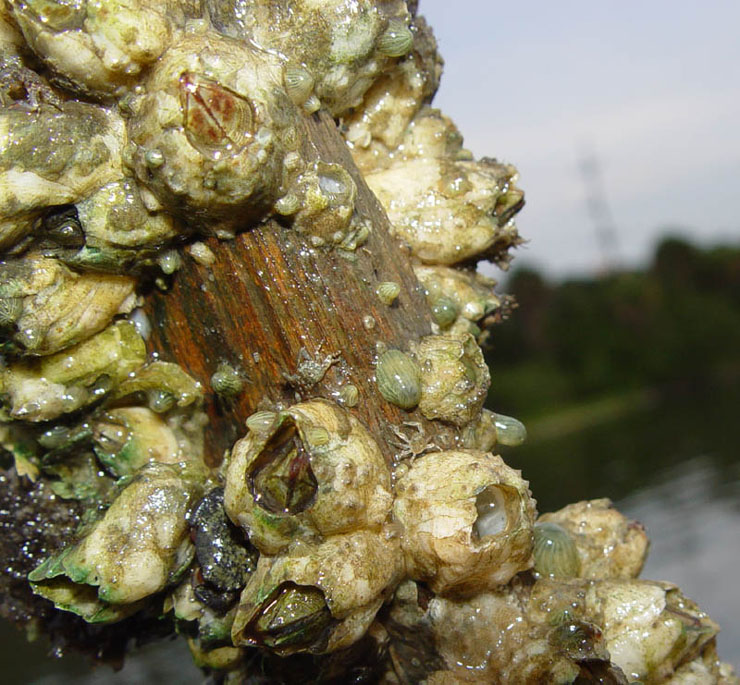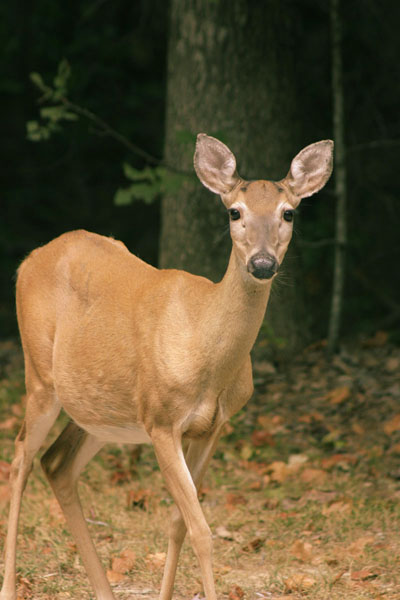 Living on the edge of the woods is a good thing. For some reason, a small herd of White-tailed Deer (Odocoileus virginianus) has taken to visiting roughly around 2:30 PM some days, and when the temperature is cool enough that I can leave the window open, I can hear them foraging. This one was a little surprised to see someone appear in the doorway so close by, but I wasn’t moving enough to spook her off, and she provided several nice portrait poses.
Living on the edge of the woods is a good thing. For some reason, a small herd of White-tailed Deer (Odocoileus virginianus) has taken to visiting roughly around 2:30 PM some days, and when the temperature is cool enough that I can leave the window open, I can hear them foraging. This one was a little surprised to see someone appear in the doorway so close by, but I wasn’t moving enough to spook her off, and she provided several nice portrait poses.
Deer are foragers, rather than grazers, which means they don’t eat grasses like cows or sheep. Instead, they seek new saplings, leaves, vines, shoots, and berries – and on occasion, garden plants and The Girlfriend’s tomatoes and peppers. In this area, they make things a little more convenient for forest wanderers like myself, because they’ll keep “greenbrier” (the colloquial name, I’m not sure of the exact species) at bay, a tough wandering vine that sports large thorns. Greenbrier can quickly turn shaded woods into impenetrable thickets, and makes walking among the trees a chore at times, but deer like it and their regular visits will keep the vine from gaining a firm hold.
Yesterday afternoon, I added some water to the thirsty potted salvia I have sitting on my railing, and as the water pooled on the soil surface before soaking in, a tiny face appeared among the leaves, startled by the sudden flood. This began a tortuous session of macro photography, as the juvenile Common Grey Treefrog (Hyla versicolor) did not want to hold still for the giant lens looming in its face, and kept hiding under the leaves. Right now, as I type this, it has ventured out of the pot and is working its way along the railing. This has me a little curious, since both of these species are primarily nocturnal and the days have been unseasonably hot, all the more reason to hole up during the days. 6:30 PM is a little early to see treefrogs getting active – night won’t fall for about another two hours.
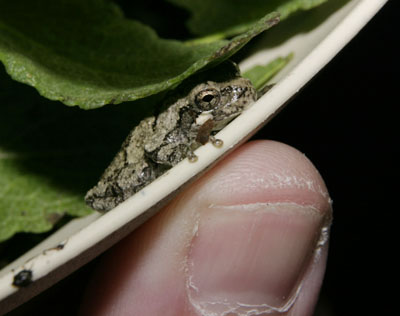 Treefrogs have distinctive toes, ending in a broad and moist pad that lets them cling to vertical surfaces effortlessly. In fact, it can be a little startling to see them jump against a wall and remain there instead of bouncing off. This trait lets them forage for food high in the tree canopies without needing claws, and also lets them scale rocks, leaves, and yes, even people that attempt to grab them. You can get an idea of the size of this specimen by my ugly thumb, included in this shot for scale. I normally see them much larger than this.
Treefrogs have distinctive toes, ending in a broad and moist pad that lets them cling to vertical surfaces effortlessly. In fact, it can be a little startling to see them jump against a wall and remain there instead of bouncing off. This trait lets them forage for food high in the tree canopies without needing claws, and also lets them scale rocks, leaves, and yes, even people that attempt to grab them. You can get an idea of the size of this specimen by my ugly thumb, included in this shot for scale. I normally see them much larger than this.
It’s a little late in the season for mating calls, so I’m not expecting to hear anything from my neighbor when it gets dark, but we’ll see what happens. I’ll probably leave a light on near the potted plant and railing, to attract the flying insects that serve as frog food. I might as well make it feel at home, since it provided enough photos for me – hey, I’m a dude ;-)





















































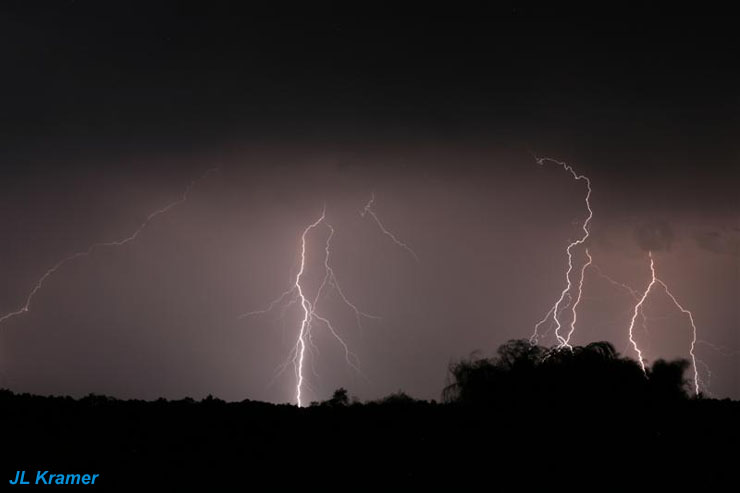
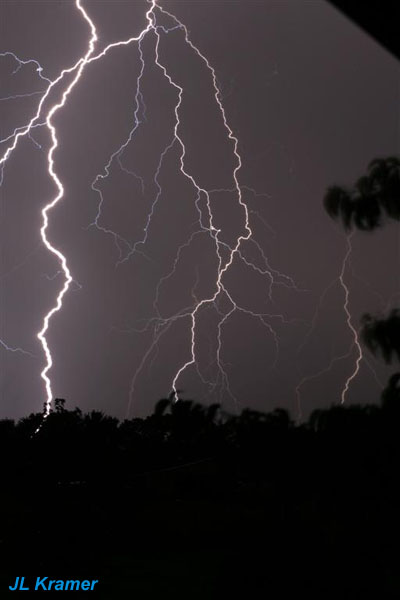 Yes, the midwestern states present some prime opportunities to get lightning photographs, due to their weather patterns and the relative flatness of the land, allowing for good views of approaching and receding storms. I expect, before too long, I’ll get to see (and mutter with jealousy over) some shots he’s gotten among some really sharp scenery or foreground interest. Lightning shots are great, but like everything, they work best if they’re situated among something else in the image that draws attention, creates a mood, or provides contrast. Many times, in order to achieve this, you need to provide some help – the storm itself will keep the skies too dark to provide any illumination of a foreground, so unless your complementary subject works well in silhouette, you need to provide some other light, or get your timing really bang on to catch the fading twilight at sunset to light up your frame, but not too much – remember, lightning usually takes long exposures while you wait for unpredictable bolts. An ideal balance is catching light immediately before sunset, peering in under the level of the storm clouds to throw some light on the ground, while the sky in your frame is darkened by the clouds themselves. Tricky, in many cases, since most storms in the US come from the west where your sunset would be. Such goes the planning of nature photography.
Yes, the midwestern states present some prime opportunities to get lightning photographs, due to their weather patterns and the relative flatness of the land, allowing for good views of approaching and receding storms. I expect, before too long, I’ll get to see (and mutter with jealousy over) some shots he’s gotten among some really sharp scenery or foreground interest. Lightning shots are great, but like everything, they work best if they’re situated among something else in the image that draws attention, creates a mood, or provides contrast. Many times, in order to achieve this, you need to provide some help – the storm itself will keep the skies too dark to provide any illumination of a foreground, so unless your complementary subject works well in silhouette, you need to provide some other light, or get your timing really bang on to catch the fading twilight at sunset to light up your frame, but not too much – remember, lightning usually takes long exposures while you wait for unpredictable bolts. An ideal balance is catching light immediately before sunset, peering in under the level of the storm clouds to throw some light on the ground, while the sky in your frame is darkened by the clouds themselves. Tricky, in many cases, since most storms in the US come from the west where your sunset would be. Such goes the planning of nature photography.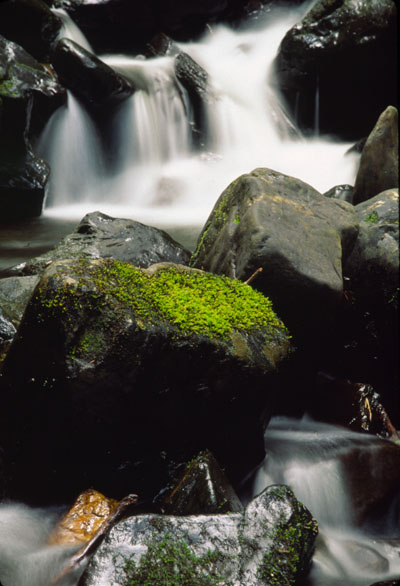 Usually, I can look at an image I take and tell pretty quickly whether it works or not, and so far my judgment seems to be, if anything, a little harsher than the average viewer. But this image has me stumped.
Usually, I can look at an image I take and tell pretty quickly whether it works or not, and so far my judgment seems to be, if anything, a little harsher than the average viewer. But this image has me stumped.
